Module 3 – Mental & Physical Exercise

LLM Online
©Arlene R. Taylor, PhD
Module #3 — Mental & Physical Exercise
Physical exercise is the single most powerful tool you have to optimize your brain function. It can improve creativity, concentration, problem-solving, and help delay the onset of any memory loss. It prepares your neurons to connect with each other, while mental stimulation allows your brain to capitalize on that readiness.
—Richard Restak, MD
To Begin
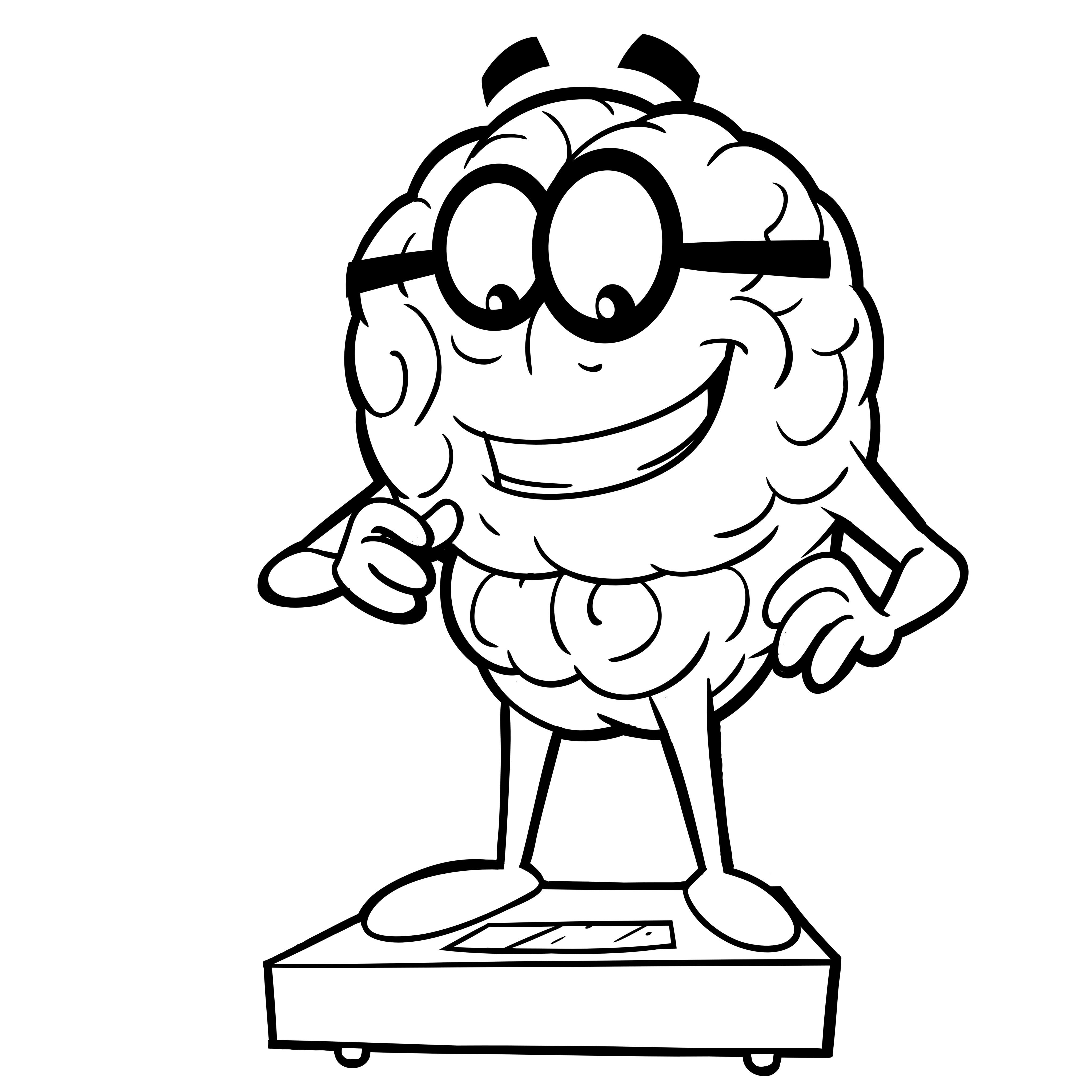 Weigh yourself in your underwear or clothes that you will wear each week on the same scales—no belt, shoes, sweater, or jacket.
Weigh yourself in your underwear or clothes that you will wear each week on the same scales—no belt, shoes, sweater, or jacket.- Measure your waist around the level of your belly button.
- Calculate your Body Mass Index using the BMI chart. Use your height in centimeters.
- Record data on the Weekly Comparison form.
- Write in your own goal on the Daily Goals form.
- Post it where you can see it easily. Record your data each day.
Physical fitness is not only one of the most important keys to a healthy body, it is the basis of dynamic and creative intellectual activity.
—John Fitzgerald Kennedy
Overview
- Brain tissue is not muscle tissue, yet it acts like muscle tissue by becoming stronger with the right type of mental exercise.
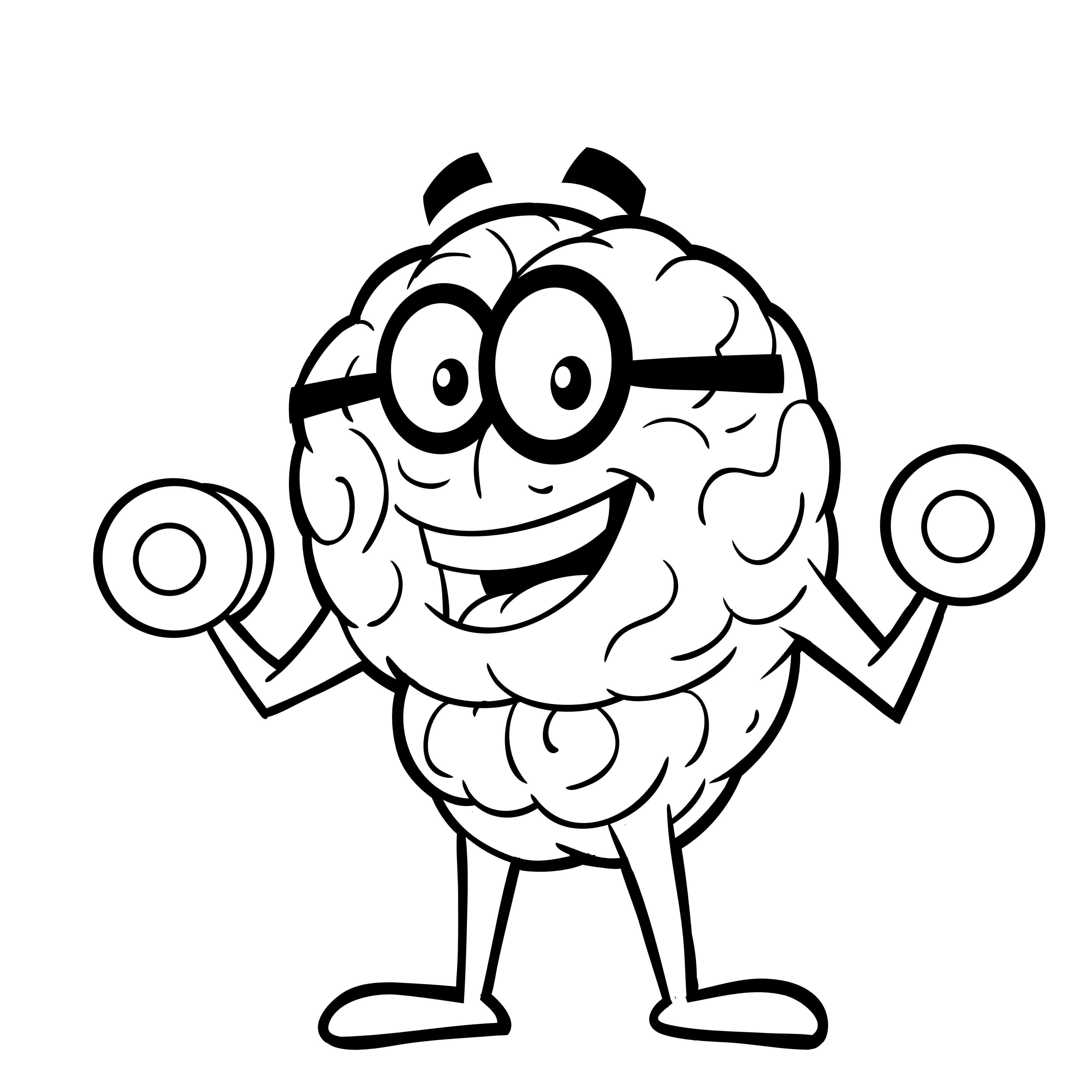
- Muscle tissue has a type of “memory” for activities and exercises that use muscle movements. That is one reason the right type of physical practice increases skill levels.
- Healthy aging of brain and body requires both systems to be exerted regularly and appropriately. Brain and body each strengthens with exercise. In both cases, it is use it or lose it.
Physical exercise improves mental health and cognitive function. Exercise makes you smart.
—Peter Blomstrand, MD, PhD
 Reminder: Get up and drink a glass of water to hydrate your brain. View the Educational Video. Stand and walk in place for at least a portion of the video to increase blood blow to your brain.
Reminder: Get up and drink a glass of water to hydrate your brain. View the Educational Video. Stand and walk in place for at least a portion of the video to increase blood blow to your brain.
Science in a Nutshell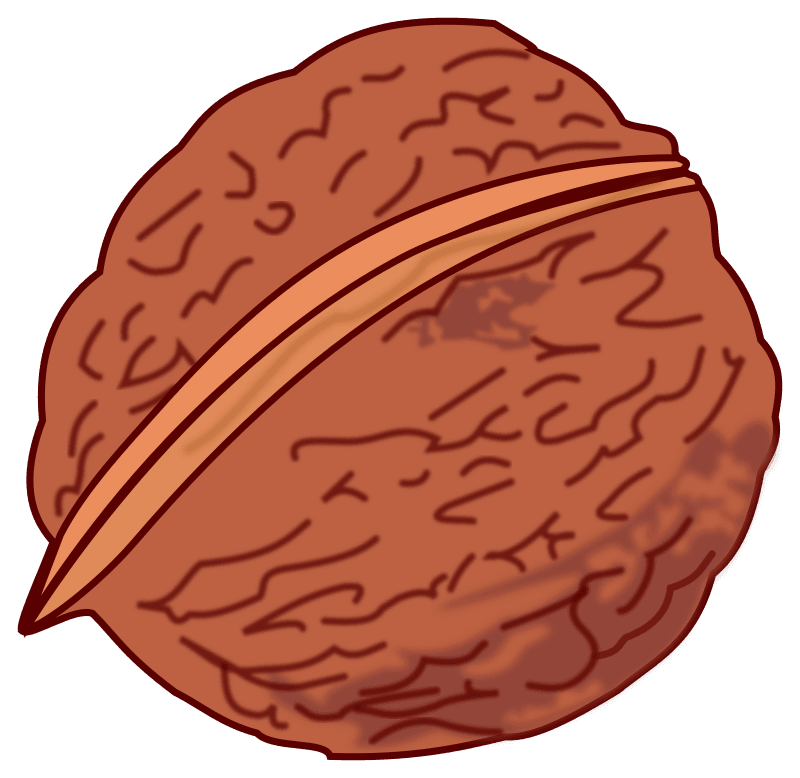
- Many say they “hate” exercising—physical or That is a mindset. Any activity is a form of physical exercise. Identify what you already do: vacuuming, washing, the car, cutting the lawn, and so on. Creative planning is activity for your brain.
- Research suggests that 30 minutes of challenging mental activity plus 30 minutes of physical activity every day equals a healthier lifestyle.
Both mental and physical exercise are linked not only with lifespan but also with maintaining physical movement and mental acuity. Who knows how much 30 + 30 could do for you!Life has no remote, so if you want to change it, you have got to get up and do it yourself.
 Challenge your brain with activities that require thinking. For example, golf is both a mental and a physical exercise. (Unless you ride around in a golf cart.) So is Table Tennis (ping pong) and some aspects of pool. Read and learn. Identify what you already do and then add some “fun” learning to your routine.
Challenge your brain with activities that require thinking. For example, golf is both a mental and a physical exercise. (Unless you ride around in a golf cart.) So is Table Tennis (ping pong) and some aspects of pool. Read and learn. Identify what you already do and then add some “fun” learning to your routine.
Lack of activity destroys the good condition of every human being, while movement and methodical exercise save it and preserve it.
—Plato
Matter of Fact
1st –
Mental exercise is all about challenging the neurons (your thinking cells) in your brain. Metaphorically, picture your hand as a neuron. Your palm is the cell body.  Your thumb is the axon, the highway by which information leaves the cell and then is carried across the synapse by neurotransmitters to other neurons. Your fingers are the dendrites that surround the cell body. The dendritic hairs—like teeth on a comb—receive information and pull it into the cell.
Your thumb is the axon, the highway by which information leaves the cell and then is carried across the synapse by neurotransmitters to other neurons. Your fingers are the dendrites that surround the cell body. The dendritic hairs—like teeth on a comb—receive information and pull it into the cell.
Studies have shown that dendrites can alter their shape in 30 seconds, and a neuron can grow a new dendrite in 30 minutes—depending on the amount of stimulation the neurons receive. It is possible for each neuron to grow at least 10,000 dendrites (fingerlike projections) to connect with other neurons. There is typically one axon by which information leaves the neuron. Some axons reach from your brain down to your toes—a long way if you are very tall! Many axons are wrapped with insulation (myelin) that help speed transmission at speeds up to 600 mph (985 km/h). This is especially true in the right hemisphere, which is slightly lighter in color—than the left hemisphere—because so many of its axons are wrapped in whitish myelin.
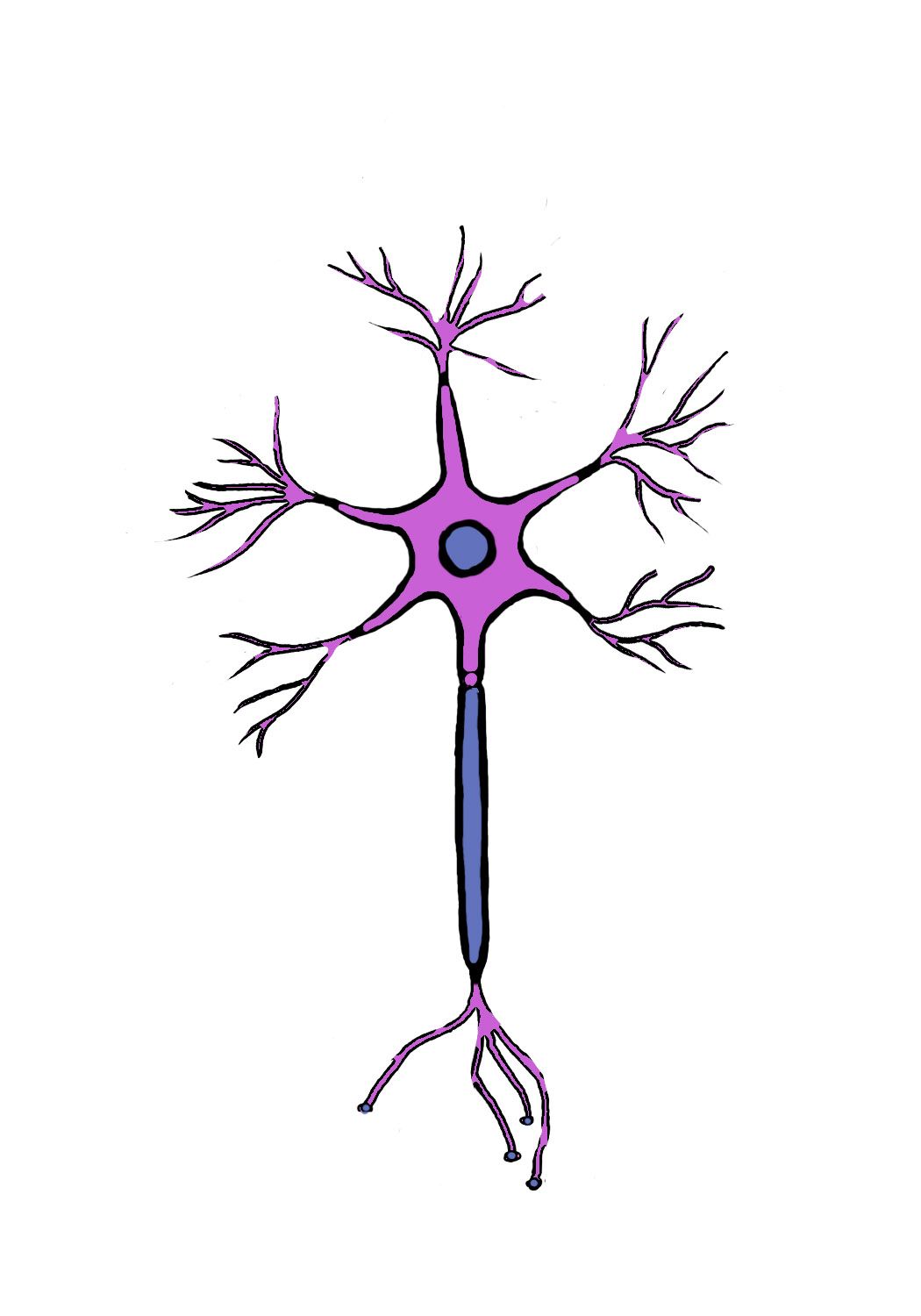 Imagine a neuron that receives low levels of stimulation looking something like a tree in winter without leaves and only bare branches. Next, imagine a neuron that receives challenging mental stimulation on a regular basis now looking like a fully leafed-out tree.
Imagine a neuron that receives low levels of stimulation looking something like a tree in winter without leaves and only bare branches. Next, imagine a neuron that receives challenging mental stimulation on a regular basis now looking like a fully leafed-out tree.
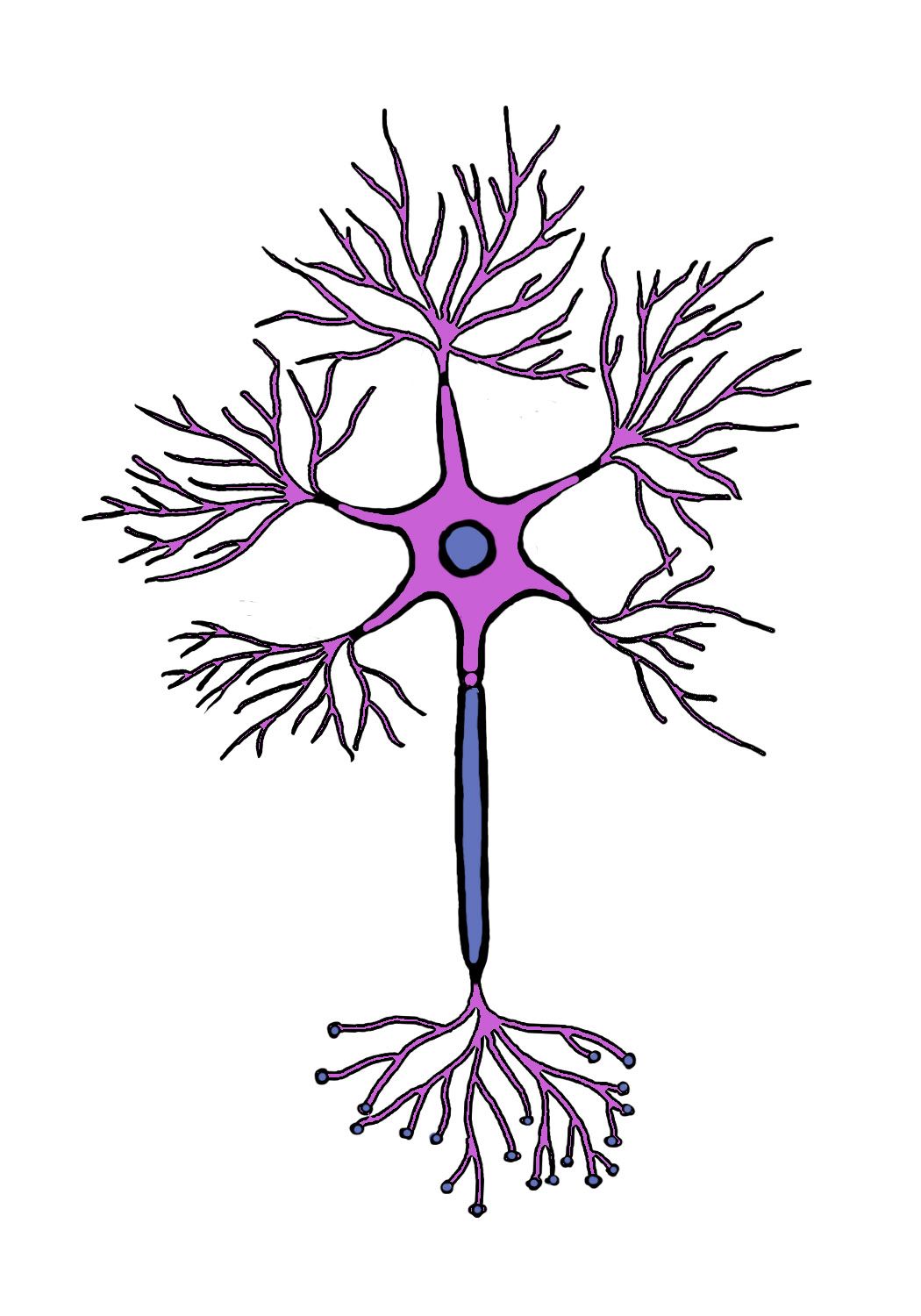
←Dendrites –with dendritic hairs or input channels
←Soma or cell body
←Axon or output channel
←Axon terminal fibers
| Compare the two neurons. Big difference! Which one do you choose? |
The connections in the brain fade away unless used. We know that early stimulation of children leads to higher cognitive scores.
—Brian Sutton-Smith
2nd –
Challenging mental stimulation is critically important to minimizing a risk of preventable dementia. Some types of dementia are the result of a lazy brain from lack of challenging mental stimulation, allowing the axons and dendrites to shrink. 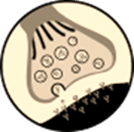 Healthy neurons never touch each other. There is a space or synapse between axon terminal fibers and the dendrites on another neuron. Chemical substances, neurotransmitters, are released from terminal fibers and carry the information across the synapse. The neurotransmitters are collected and brought back to the terminal fibers ready for next time.
Healthy neurons never touch each other. There is a space or synapse between axon terminal fibers and the dendrites on another neuron. Chemical substances, neurotransmitters, are released from terminal fibers and carry the information across the synapse. The neurotransmitters are collected and brought back to the terminal fibers ready for next time.
Here is the catch: If not stimulated on a regular basis, neurons—along with their axons and dendrites—can atrophy or shrink. This widens the synapse (space) between neurons, making the transfer of information from one neuron to another more difficult. When the synapse (space between neurons) becomes too wide from lack of regular stimulation, the transmission of information between neurons is interrupted. This can result in “interrupted thinking.”
| First say to yourself what you would be; and then do what you have to do. |
Interruption of information transmission can show up as symptoms of dementia. This type of dementia appears to be preventable and sometimes can be reversed if caught in time. 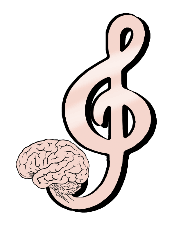 Some studies have shown that when these individuals were helped to challenge their brains on a daily basis using mental games, reading, listening to audio books, music, combined with physical activity, the symptoms could be slowed and sometimes reversed.
Some studies have shown that when these individuals were helped to challenge their brains on a daily basis using mental games, reading, listening to audio books, music, combined with physical activity, the symptoms could be slowed and sometimes reversed.
Pre-dementia, also referred to as “mild cognitive impairment,” is characterized by problems such as memory issues, confusion, and mood swings—challenges known to disrupt daily life. Studies with 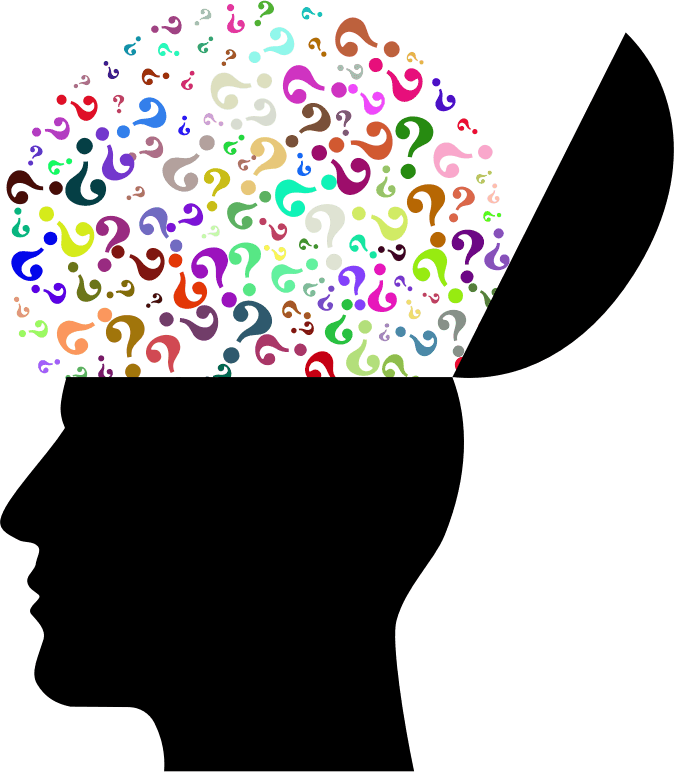 Veterans reveal that patients who display apathy (i.e., indifference) are up to seven times more likely to develop dementia. Estimates are that about 15 percent of individuals age 65 and older who are diagnosed with pre-dementia will go on to evidence full-blown dementia. Do something every day to keep your brain interested! Even when dementia cannot be completely avoided, if the process can be slowed to give the individual a few more years of reasonable cognitive function, it is worth it.
Veterans reveal that patients who display apathy (i.e., indifference) are up to seven times more likely to develop dementia. Estimates are that about 15 percent of individuals age 65 and older who are diagnosed with pre-dementia will go on to evidence full-blown dementia. Do something every day to keep your brain interested! Even when dementia cannot be completely avoided, if the process can be slowed to give the individual a few more years of reasonable cognitive function, it is worth it.
The dominant theory coming out of Hollywood is that peoples' attention spans are getting shorter and shorter and they need more stimulation.
—Brian Eno
 Reminder: Get up and drink a glass of water. Listen to Chapter 4 of “Just the Facts.” If possible, walk around the room while you listen. At least walk in place.
Reminder: Get up and drink a glass of water. Listen to Chapter 4 of “Just the Facts.” If possible, walk around the room while you listen. At least walk in place.
3rd –
Brain aerobics are just one of many ways to “use it,” if you will, to retain optimum brain function for as long as possible. Following are a few suggestions to get you started:
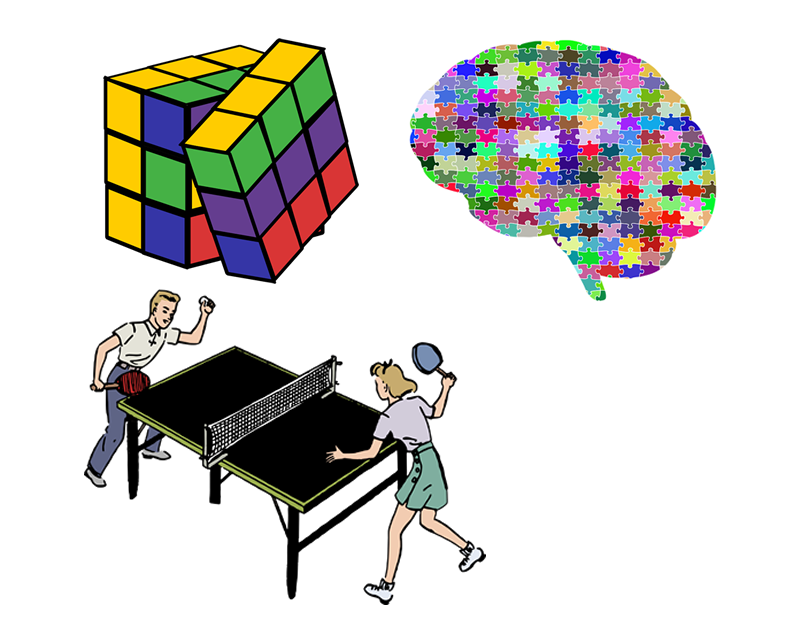 Play games. Crossword puzzles. Sudoku and Rubik’s Cube. Mazes. Jig-saw puzzles. Chess. Get an adult coloring book. You might try table tennis or pickleball. The options are endless.
Play games. Crossword puzzles. Sudoku and Rubik’s Cube. Mazes. Jig-saw puzzles. Chess. Get an adult coloring book. You might try table tennis or pickleball. The options are endless.
- Read aloud for ten minutes a day to promote more brain-function activity and language development in both children and adults. Listen to audio books.
- Travel can expose your brain to new sights, sounds, smells, tastes, people, and environments. The brain loves variety and finds it stimulating. “Travel” locally in your own city or town to visit places that are new. If you can travel nationally and internationally, you may want to consider that.
- If you play an instrument, keep practicing on a regular basis. If not, it is rarely (if ever) too late to learn.
 Playing an instrument can help age-proof your brain. Sing, whistle. Listen to positive, cheerful music. Music is one of the few activities known to stimulate, activate, and engage the entire brain.
Playing an instrument can help age-proof your brain. Sing, whistle. Listen to positive, cheerful music. Music is one of the few activities known to stimulate, activate, and engage the entire brain.
- Develop a challenging and rewarding hobby. Volunteer in a genre of interest to give back to the planet. Read to the visually impaired. Learn sign language so you can communicate with the hearing impaired. Volunteer to have phone, zoom, or face-time conversations with people who need brain stimulation. Ask them to tell you stories about their childhood--and listen. And so on . . .
 Learn to use a computer and do Internet searches. Make your life a treasured treasure hunt. Some studies have shown that, for those over 55, doing a complex Internet search can be as stimulating as reading a book.
Learn to use a computer and do Internet searches. Make your life a treasured treasure hunt. Some studies have shown that, for those over 55, doing a complex Internet search can be as stimulating as reading a book.
- Check out Brain Exercises on Taylor’s website.
https://arlenetaylor.org/resources/brain-exercises
When you listen to music, multiple areas of your brain become engaged and active. But when you actually play an instrument, that activity becomes more like a full-body brain workout.
—Anita Collins, PhD
4th –
“Use it and move it or lose it“ has been applied to body muscles for years. Choose your physical activities and exercise routines with care, however. The advice of Hippocrates still stands: Do no harm. For example, after decades of being touted as beneficial, jogging (when compared with walking or running) is getting mixed reviews for the average person. Over time, jogging can damage joints, stretch ligaments, and may even compound cellulite.
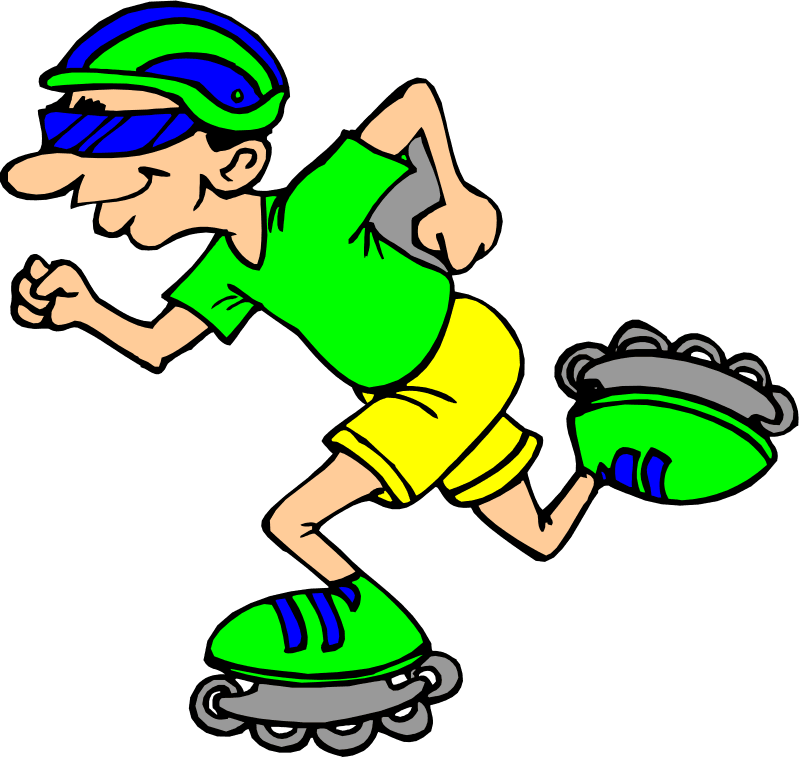 If you enjoy intensity training, alternate several minutes of brisk walking, biking, or rowing with several minutes of more moderate exercise. Walking for many people is an excellent form of exercise. That is one of the plusses of owning a little dog and taking your pet for a daily walk or two. Swimming, as a low-impact exercise, may be another option.
If you enjoy intensity training, alternate several minutes of brisk walking, biking, or rowing with several minutes of more moderate exercise. Walking for many people is an excellent form of exercise. That is one of the plusses of owning a little dog and taking your pet for a daily walk or two. Swimming, as a low-impact exercise, may be another option.
Some individuals over-exercise, becoming addicted to the adrenalin, endorphins, and dopamine secreted when the body begins to feel pain. Too little exercise is unhelpful, along with exercise routines that are too long or too intense.
Note: If you are accustomed to being sedentary, consult your physician or other healthcare professional before beginning an exercise program.
Those who think they have no time for bodily exercise will sooner or later have to find time for illness.
—Edward Stanley
5th –
| Mental inertia is death. —Timothy Thomas Fortune |
The physical-mental link is gaining more attention. For example, studies have shown that Individuals who are aerobically fit may also have an intellectual edge. The brain loves variety. Much as the body craves food and physical activity, your brain craves information and novelty. Brain stimulation is essential for every brain and critical for the aging brain, which may have a tendency toward mental laziness—especially after retirement.
 Avoid zoning out in front of the TV. Watching movies and television uses a process known as passive mental picturing. Your brain is passively processing what another brain created. Instead, maximize active mental picturing. This means engagement in stimulating and challenging mental activities for at least 30 minutes a day to keep your brain neurons active. This helps to keep neuronal axons and dendrites stretched out—keeping the space (synapse) between them as small as possible.
Avoid zoning out in front of the TV. Watching movies and television uses a process known as passive mental picturing. Your brain is passively processing what another brain created. Instead, maximize active mental picturing. This means engagement in stimulating and challenging mental activities for at least 30 minutes a day to keep your brain neurons active. This helps to keep neuronal axons and dendrites stretched out—keeping the space (synapse) between them as small as possible.
There are really only two requirements when it comes to exercise: one is that you do it; the other is that you continue to do it.
—Jennie Brand-Miller
 Reminder: Get up and drink a glass of water. Listen to Chapter 5 of “Just the Facts.” If possible, walk around the room while you listen. At least walk in place.
Reminder: Get up and drink a glass of water. Listen to Chapter 5 of “Just the Facts.” If possible, walk around the room while you listen. At least walk in place.
6th –
Physical exercise is vitally important for both brain and body in several ways. It strengthens the heart, bolsters the immune system, boosts energy, relieves stress, enhances cognition, and improves sleep.
 The value of exercise has less to do with building muscles or burning calories and more to do with getting the heart to pump faster and more efficiently, thereby increasing blood flow to nourish the brain and body organs and simultaneously removing waste products. When operating correctly, the circulatory system is a very effective two-way distribution system. It delivers oxygen, glucose, and other essential micronutrients to each cell. In turn, it picks up and carries away carbon dioxide and other waste products. The exercise of large muscle groups facilitates the return of blood to the heart through the veins and lymph fluid through the lymph vessels.
The value of exercise has less to do with building muscles or burning calories and more to do with getting the heart to pump faster and more efficiently, thereby increasing blood flow to nourish the brain and body organs and simultaneously removing waste products. When operating correctly, the circulatory system is a very effective two-way distribution system. It delivers oxygen, glucose, and other essential micronutrients to each cell. In turn, it picks up and carries away carbon dioxide and other waste products. The exercise of large muscle groups facilitates the return of blood to the heart through the veins and lymph fluid through the lymph vessels.
Blood circulates through the body at least once a minu te¾and sometimes two or three times a minute depending on your heart rate and your activity. Each day, every cell in the blood travels the equivalent of nearly half-way around Planet Earth at its Equator! With the circumference of the Equator approximately 25,000 miles (40,200 kilometers), your little blood cells get in a whopping bit of travel over a 48-hour period.
te¾and sometimes two or three times a minute depending on your heart rate and your activity. Each day, every cell in the blood travels the equivalent of nearly half-way around Planet Earth at its Equator! With the circumference of the Equator approximately 25,000 miles (40,200 kilometers), your little blood cells get in a whopping bit of travel over a 48-hour period.
The brain is a growing changing organ, its capabilities and vitality dependent to a large degree on how you nourish and treat it.
—Jean Carper
 Reminder: Time to get up and drink a glass of water. Watch the short Birds & Brains video. Stand and walk in place for at least part of the video.
Reminder: Time to get up and drink a glass of water. Watch the short Birds & Brains video. Stand and walk in place for at least part of the video.
7th –
Physical exercise is an anti-aging strategy. Variety is key to keeping your brain interested and motivated, so select activities and exercises you enjoy. Be creative.  You need a healthy body to carry your brain around, and you want a healthy brain while your body is transporting it hither and yon. Even small changes can contribute to enhanced health and longevity. Nearly everyone can find a way to obtain the physical activity and exercise their brains and bodies require. Concentrate on what you can do and stop fretting about what you cannot do. Stop making excuses.
You need a healthy body to carry your brain around, and you want a healthy brain while your body is transporting it hither and yon. Even small changes can contribute to enhanced health and longevity. Nearly everyone can find a way to obtain the physical activity and exercise their brains and bodies require. Concentrate on what you can do and stop fretting about what you cannot do. Stop making excuses.
| It is exercise alone that supports the spirit and keeps the mind in vigor. —Cicero |
Minimize sitting and maximize physical activity. If you are doing largely sedentary work, do some standing at a raised desk, if possible. Move around for a couple minutes every half hour, setting a timer if need be. Aim to exercise 30 minutes each day, possibly in sections of 10 or 15 minutes if that works better for your schedule. During each week include some stretching, aerobics, endurance, balance, and flexibility exercises.
Remember that routine activities can count as “physical exercise”: vacuuming; washing the car; hauling bags of groceries to your car and then into your home before finally putting them away—and so on. Bottom line: stay active.
Everything is energy, and that’s all there is to it. Nothing happens until something moves.
—Albert Einstein
Practical Applications
 Keep your brain strong through mental activity. Keep your muscles strong through physical activity. Movin’ and groovin’, as the kids would say. Make mental and physical exercise a habit. According to Candace B. Pert, PhD, 20 minutes of mild aerobic exercise at the beginning of the day turns on fat-burning neuropeptides, the effects of which can last for hours. This can be critical in managing diseases such as obesity and diabetes. In the book Brain Rules, Medina explains that upping your daily exercise to a 20-minute walk could cut your risk of a stroke by 57 percent.
Keep your brain strong through mental activity. Keep your muscles strong through physical activity. Movin’ and groovin’, as the kids would say. Make mental and physical exercise a habit. According to Candace B. Pert, PhD, 20 minutes of mild aerobic exercise at the beginning of the day turns on fat-burning neuropeptides, the effects of which can last for hours. This can be critical in managing diseases such as obesity and diabetes. In the book Brain Rules, Medina explains that upping your daily exercise to a 20-minute walk could cut your risk of a stroke by 57 percent. Willpower, an executive function, can be defined as the “energetic determination to carry out your chosen plans and decisions.” It is designed to help you create a new behavior. Willpower is not designed to stop bad habits, especially those that give you a hit in the Brain Reward System. Picture in your mind’s eye what you want to do for mental and physical exercise: then access willpower help you actually do it.
Willpower, an executive function, can be defined as the “energetic determination to carry out your chosen plans and decisions.” It is designed to help you create a new behavior. Willpower is not designed to stop bad habits, especially those that give you a hit in the Brain Reward System. Picture in your mind’s eye what you want to do for mental and physical exercise: then access willpower help you actually do it.
Only one thing registers on the subconscious mind: repetitive application—practice.
—Grace Speare

Reminder: Get up and drink a glass of water as you dig into this last section. How are you choosing to apply this information practically in your everyday life?
Think & Do
- Brain and body exercise matter! Name two long-term benefits of mental exercise and of physical exercise.
Have you been neglecting either mental or physical exercise? 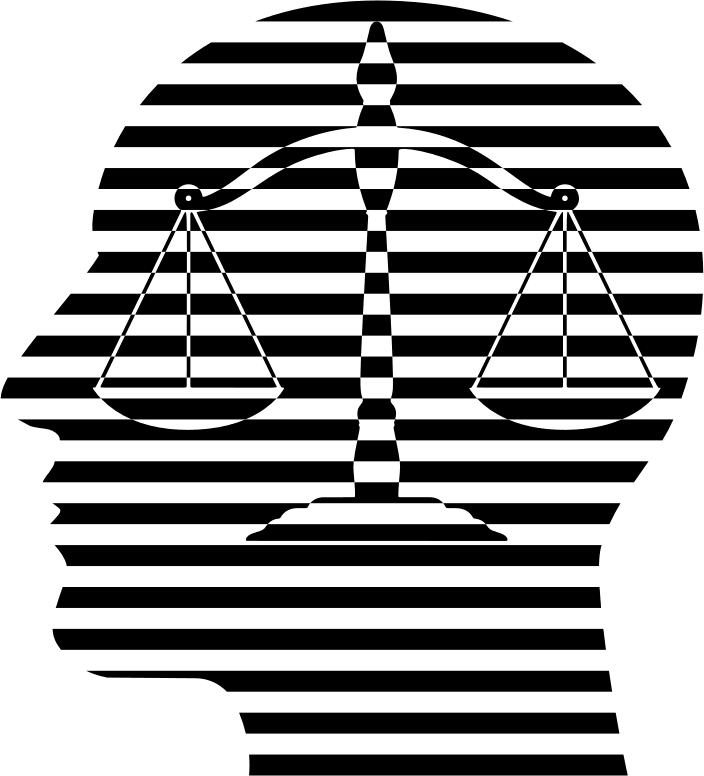 The brain and body work best in balance. A Longevity Lifestyle is all about balance. Out-of-balance-exercising (e.g., over-exercising or under-exercising) can be detrimental.
The brain and body work best in balance. A Longevity Lifestyle is all about balance. Out-of-balance-exercising (e.g., over-exercising or under-exercising) can be detrimental.
Are you doing some type of both mental and physical exercise each day—in balance?- Brain and body health go hand-in-hand. Thomas Edison reportedly thought the brain so important that he believed the body’s primary responsibility was to carry the brain around. Without a healthy body, the brain would be limited in where it could go. Perhaps even be stuck in one place! You need a healthy body to transport the brain safely and efficiently from place to place. Without a healthy brain, the body might wonder why bother transporting the brain anywhere.
Have you thought about this before?
In life, you always give up something to get something. No one can ever have it all. To be healthy you may need to give up something to plan time for mental and physical exercise. In the long term, what could be more important than taking good care of your brain and body? In the end, a healthier and longer future is at stake!
If you want to know what your thoughts were like in the past, look at your body today. If you want to know what your body will be like in the future, look at your thoughts today.
—Rudolph E. Tanzi, Deepak Chopra, MD
Slow & Steady Wins
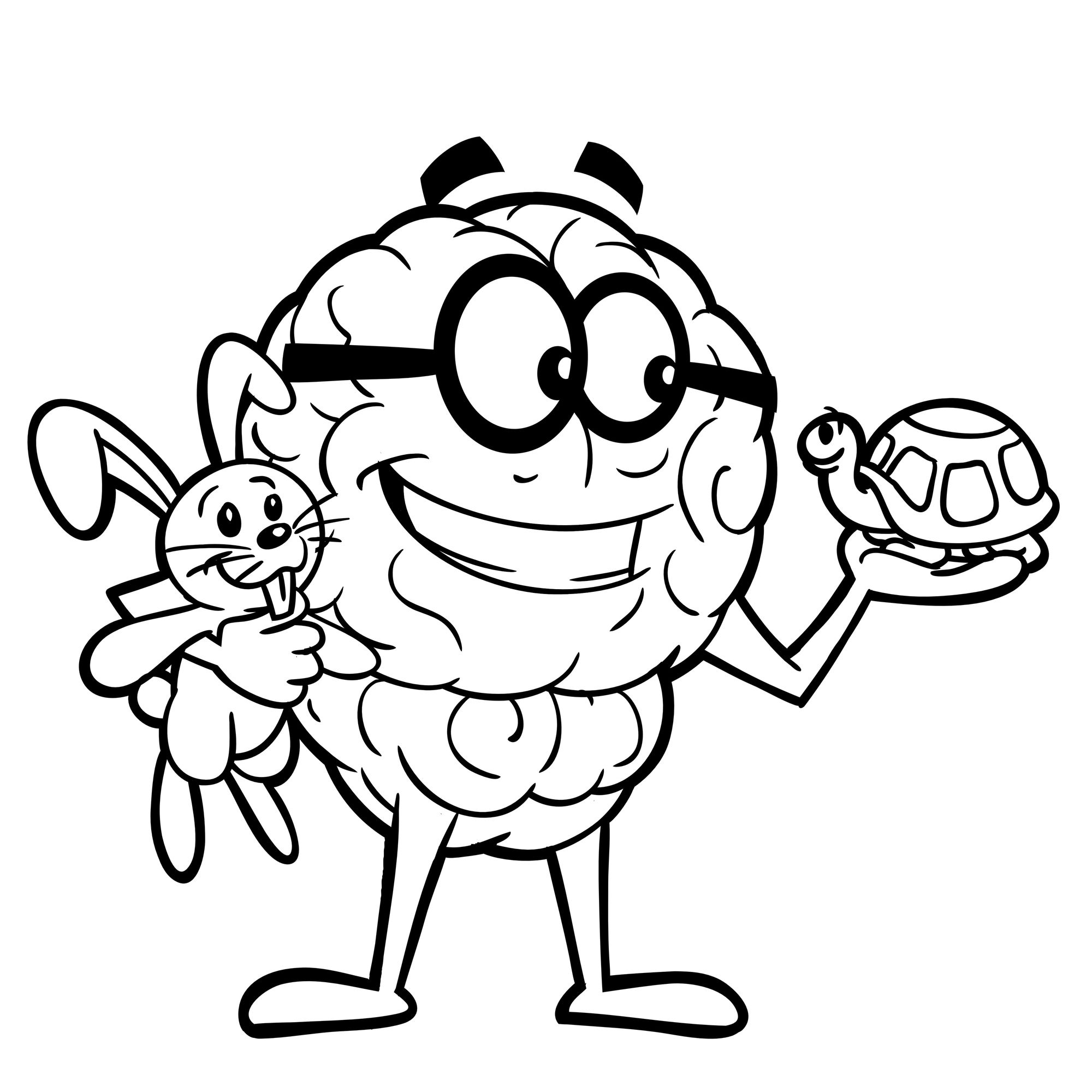 Concentrate on Module 3 during this entire week. Do your Daily Goals; reread the sections; relisten to the Videos and audiobook excerpts. It takes the average adult four times through to really absorb the material and turn it into a new behavior. If you want positive results, rushing through the material--just because you can--may not provide the desired outcome.
Concentrate on Module 3 during this entire week. Do your Daily Goals; reread the sections; relisten to the Videos and audiobook excerpts. It takes the average adult four times through to really absorb the material and turn it into a new behavior. If you want positive results, rushing through the material--just because you can--may not provide the desired outcome.
Practice, practice, and practice physical and mental exercise. Get plenty of sleep so your brain has time to ‘consolidate’—transfer—what you are learning from short term to long term memory. Drink plenty of water to keep your brain hydrated and able to generate the mental energy you need. Your thinking cells—called neurons—are estimated to be about 85 percent water. Dehydration is deadly in brain central.
Use what you have been learning: Can-do Mindset, Positive Self-talk, and EQ skills to make a plan for mental and physical exercise that works for you. Then access Willpower to help integrate them into your longevity lifestyle.
To recharge themselves, individuals need to recognize the costs of energy-depleting behaviors and then take responsibility for changing them, regardless of the circumstances they are facing.
—Harvard Business Review, 2007
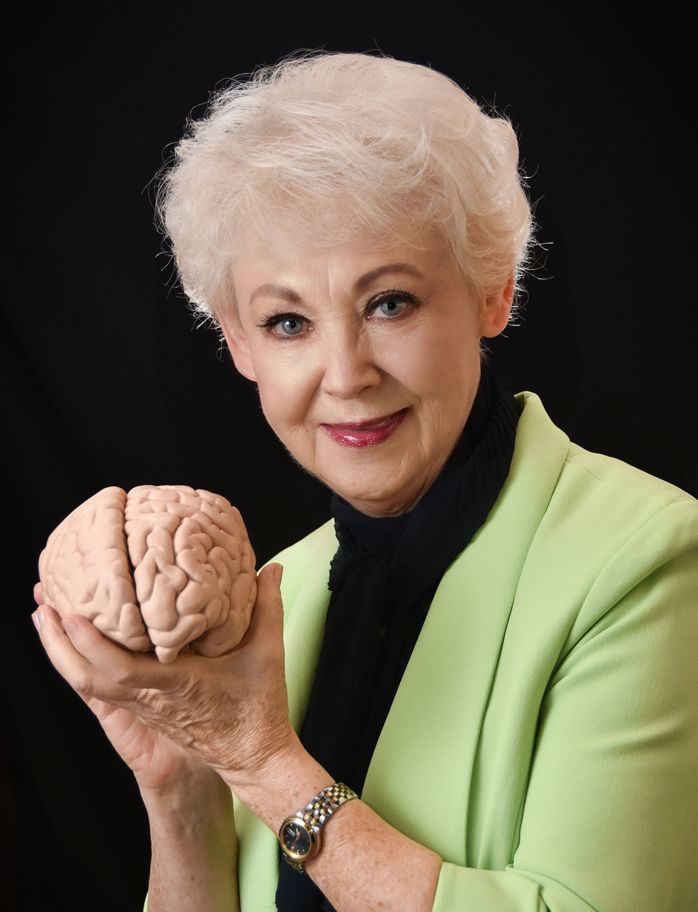 See you next week for LLM Online Module 4
See you next week for LLM Online Module 4
Topic:
Optimum Sleep – Sleep is independently linked with longevity.
Lesson List
- Module 2 – Emotional Intelligence (EQ)
- Module 2 – To Begin
- Module 2 – Slow & Steady Wins
- Module 1 – Mindset and Self-talk
- Module 1 – To Begin
- Module 1 – Slow & Steady Wins
- Module 1 – Mindset (educational video)
- Module 1 – Birds & Brains (video)
- Module 1 – Just the Facts - Chapter 1 (audio)
- Module 1 – Just the Facts - Chapter 2 (audio)
- Module 2 – EQ (Emotional Intelligence) (video)
- Module 2 – Just the Facts - Chapter 3 (audio)
- Module 4 – Sleep
- Module 4 – To Begin
- Module 4 – Slow & Steady Wins
- Module 3 – Mental & Physical Exercise
- Module 3 – To Begin
- Module 3 – Slow & Steady Wins
- Module 5 – Water
- Module 5 – To Begin
- Module 5 – Slow & Steady Wins
- Module 6 – Safety
- Module 6 – To Begin
- Module 6 – Slow & Steady Wins
- Module 7 – Sunlight
- Module 7 – To Begin
- Module 7 – Slow & Steady Wins
- Module 8 – Nutrition
- Module 8 – To Begin
- Module 8 – Slow & Steady Wins
- Module 10 – Support Network
- Module 10 – To Begin
- Module 11 – Stressors
- Module 10 – Slow & Steady Wins
- Module 9 – Laughter
- Module 9 – To Begin
- Module 11 – To Begin
- Module 9 – Slow & Steady Wins
- Module 11 – Slow & Steady Wins
- Module 12 – Life Satisfaction
- Module 12 – To Begin
- Module 12 – Slow & Steady Wins
- Module 2 — Birds & Brains, No. 2 - EQ (video)
- Module 3 – Exercise (educational video)
- Module 3 – Just the Facts - Chapter 4 (audio)
- Module 3 – Just the Facts - Chapter 5 (audio)
- Module 3 – Birds & Brains, No. 3 - Exercise (video)
- Module 4—Just the Facts - Ch. 6 (audio)
- Module 4—Birds & Brains #4 (video)
- Module 4—Sleep (educational video)
- Module 5—Water (educational video)
- Module 5 – Just the Facts - Chapter 7 (audio)
- Module 5 — Birds & Brains #5 (video)
- Module 6 – Safety (educational video)
- Module 6 – Just the Facts - Chapter 8 (audio)
- Module 7 – Birds & Brains #7 (video)
- Module 8 – Just the Facts - Chapter 10 (audio)
- Module 8 – Nutrition (educational video)
- Module 8 – Birds & Brains #8 (video)
- Module 7 – Just the Facts - Chapter 9 (audio)
- Module 6 — Birds & Brains #6 (video)
- Module 7 – Sunlight (educational video)
- Module 9 – Laughter (educational video)
- Module 9 – Just the Facts - Chapter 11 (audio)
- Module 9 – Birds & Brains #9 (video)
- Module 10 – Support Systems (educational video)
- Module 10 – Just the Facts - Chapter 12 (audio)
- Module 10 – Birds & Brains, No. 10 - Support Systems (video)
- Module 11 – Stressors (educational video)
- Module 11 – Just the Facts - Chapter 13 (audio)
- Module 11 – Birds & Brains No. 11 - Stressors (video)
- More Information
- Module 12 – Life Satisfaction (educational video)
- Module 12 – Birds & Brains, No. 12 - Life Satisfaction (video)
- Module 12 – Just the Facts - Chapter 14 (audio)
Teachers Info

Arlene R. Taylor, PhD
- Specialist:
- Website: https://www.arlenetaylor.org/
-
Arlene R. Taylor PhD, a leading speaker on brain function, is sometimes referred to as the brain guru. She specializes in simplifying this complex topic, with the goal of helping individuals understand more about the brain in general and their own in particular. She delights in helping others learn how to thrive by...

